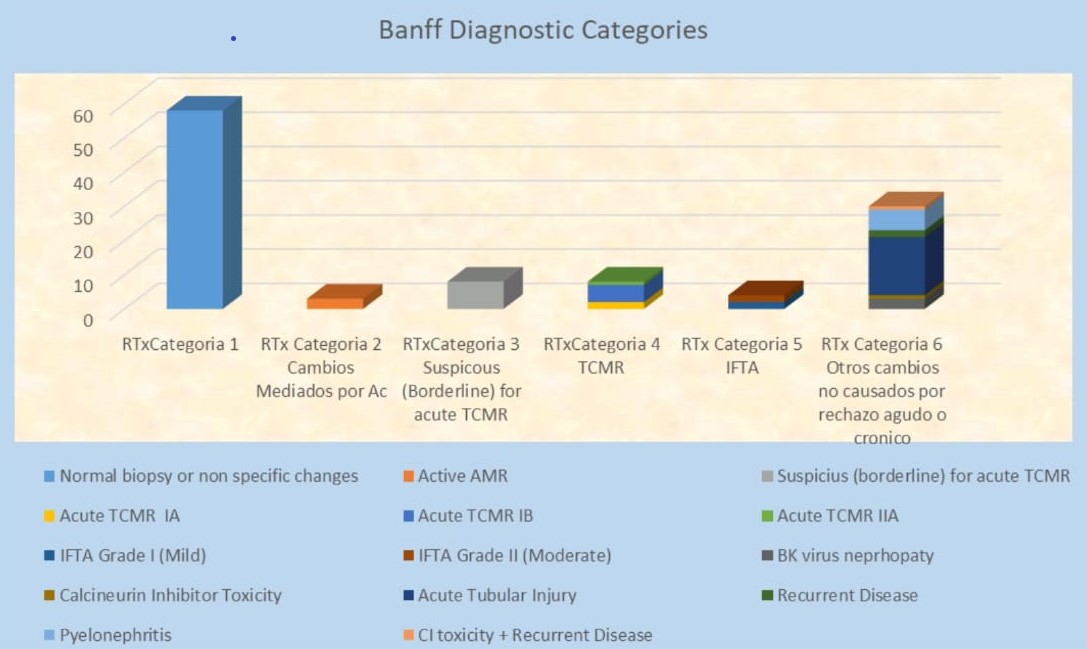Kidney graft surveillance biopsies, histological findings and safety of the procedure
Maria Nieves I Aran1, Valeria Alberton2, Horacio D Curcio1, Sergio Copottelli1, Maria Eugenia Zoppi1, Daniela Wojtowicz1, Rita A Canale1, Florencia Williams1, Alejandro Lopez Montero3, Silvia Di Pietrantonio1.
1Nefrologia y Trasplante Renal, Hospital El Cruce, Florencio Varela, Argentina; 2Anatomia Patológica, Hospital El Cruce, Florencio Varela, Argentina; 3Diagnóstico por Imágenes, Hospital El Cruce, Florencia Varela, Argentina
Introduction: Surveillance biopsy is to date, the best available tool to assess the graft’s condition, identifying histological changes before kidney function shows any substantial change. Surveillance biopsy is not a routine practice in many transplant centers; we perform those three months after transplant, in patients with stable kidney function and, one year after transplant, only in special clinical situations. These are performed as an outpatient procedure and with ultrasound guidance.
Methods: 108 surveillance biopsies, performed between October 2016 and January 2022, in patients over 18 years old, who had received kidney transplant (n=99) and liver kidney transplant (n=6) were retrospectively analyzed. Demographic, clinic and laboratory data, pathology reports (categorized according the last Banff classification 2018) and data regarding complications from the procedure, were collected.
Results: 108 kidney graft surveillance biopsies, 6 of them were performed in patients who received combined liver-kidney transplant and 103 in patients who received kidney transplant. 51.85% were men, with a mean age of 43.65 +/- 13.35 (20-75). The mean time between transplant and the biopsy was 5.4 +/- 3.8 months. 74 of them were performed within the stipulated time (3 +/- 2 months), 31 procedures were delayed due to several reasons, such as unavailability, urinary tract infection, anticoagulated patient, COVID pandemic, etc. and 3 second surveillance biopsies performed at 12 +/- 3 months. The mean creatinine at the time of the biopsies was 1.39 +/-0.54 (0.43-2.98). Histological findings are shown in Figure 1.

The number of glomeruli per sample was 22.7 +/- 10.4 (5-67), 5 (4.62%) samples were defined as insufficient (<10 glomeruli). Treatment’s changes were made in 23 (21.29%) patients after receiving the histology report. Regarding complications due to the procedure, in 11.11%, minor complications occurred, 6 patients with self-limited macroscopic hematuria, 1 of them required hospitalization for observation and was discharged after 24hours, 7 asymptomatic hematomas were detected in the post biopsy control ultrasound and 1 pseudoaneurysm as a major complication, which required hemodynamic embolization. There were no graft losses or deaths related to the procedure.
Conclusion: kidney graft surveillance biopsy is a valuable tool that is part of the post-transplant follow-up standard, since it is an objective way to systematically demonstrate early histological changes that allow the implementation of prevention and management strategies that impact in the long term outcomes. We believe that the low rate of complications and the number of changes in treatment with diagnosis justify continuing this practice.

right-click to download
